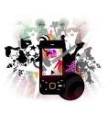

Jon Kwan — Head Of Strategy at M&C Saatchi Mobile, a full-service mobile marketing agency whose clients include Speedo, Harper Collins and Reebok — tells us what brands really want from mobile – and why.
A raft of recent reports and ad network data show that key factors, such as smartphone penetration, mobile Internet usage and unlimited data plans, are aligned to move mobile marketing a huge step forward.
Another indicator that heralds healthy mobile marketing growth is the decision by major companies to dedicate more budget to mobile. A survey developed by Jumptap, a provider of targeted mobile advertising in conjunction with publisher DM2 Media, points to an upward trend. The first “State of Mobile Advertising” survey (released March 2011) aggregates responses from nearly 350 mobile advertising executives including brands, agencies, publishers and technology enablers.
Among the findings: 60 percent intend to draw their mobile budget from their current online budget. An additional 20 percent said that mobile will be an entirely new line item.


Mobile marketing microcosm
A key indicator of mobile megatrends could be the evolution of M&C Saatchi Mobile itself. Since M&C Saatchi acquired Inside Mobile last April the company has “experienced a surge” in interest and activity, with more brands requesting proposals for apps and mobile sites. First it was about the iPhone, but Jon notices that more brands are waking up to Android apps, as well as apps for tablet devices and renewed interest in mobile Internet sites.
As a result the agency has grown from just 6 people to 30 in the London offices. More importantly, the roster of brands getting serious about mobile is also on the rise. “They are recognizing or having the foresight to start carving out their presence on mobile to stay ahead of the pack [of competitors]. But they are also on mobile because that’s where consumers – their audience – is.”
Exploration to execution
Last October Paul Berney, CMO of the Mobile Marketing Association, told the audience at the MMA Forum in London that the industry had officially made the milestone move from evangelizing to execution. Does Jon see the same trend?
“Absolutely! Clients and consumers alike are much more savvy now. Some brands we have pitched in the past have come back a year later. The difference is: now they have a budget.” In fact, Jon reports “more enlightened brands are asking us to look at mobile strategy for the next three years.”
Granted, mobile may still be a small portion of brand budgets, but it is a number that is on the rise. As Jon puts it: “This year has seen a decent increase in spend, especially in mobile media.” Put another way, brands are not just dipping a toe in the water. Today “it’s more like a foot or a leg up to the knee.” However, high-profile successes and case studies are offering undeniable proof of the power of mobile. “Brands can’t ignore the transactions and just the amount of engagement that campaigns, [mobile] websites and apps generate.”
So what needs to happen to move the dial on mobile ad spend?
Jon says this is starting to happen already. Increasingly, brands are understanding that it’s not just about first-mover advantage. It’s about the hard truth that people live their lives on their mobile devices. “It’s just a natural progression. Mobile is where people are starting to engage [with brands].” The brands that “get” it are moving full-steam to connect with consumers. “There are still cautious brands that will wait, but they will spend more [in the end] because they wait.” It seems that mobile — like money — never sleeps.
Combine, don’t compete
What are the barriers and how has this changed over the last months? I recounted the arguments we hear at industry events and conferences and asked Jon to weigh in with his real-life observations.
Is it the agencies — organizations incentivized to deliver campaigns focused on reach and frequency – who are losing the plot when it comes to harnessing the personal nature of mobile to deliver results?
Granted some agencies may still have a lot to learn about mobile, but Jon says there’s no ignoring what the client wants. “I don’t think agencies have a choice. Consumer behavior has changed and will lean even more towards mobile as people move their daily routines — everything they do and were doing online — to mobile.”
Admittedly, “the money around the average TV campaign is much more than a mobile app and promotion campaign.” But the competition for spend isn’t as fierce as it used to be. The emergence of cross-media campaigns that harness all media (from text to TV and billboards to barcodes) mean that mobile is “another string on the bow.” Agencies and their clients have a new mindset. “It’s about how to make the most of mobile and integrate it into their thinking, rather than thinking about what mobile might replace.”
Numbers that count
What about the metrics? Is a mismatch between CPM and CPC (measurements that reward a mass-market reach) hindering the development of mobile marketing?
The argument is that mobile marketing – unlike broadcast – requires the advertiser (and the agency) to tailor the message to the medium (and the audience). So it’s a different game with different rules. Should it be measured (and valued) differently?
For Jon, the metrics from the online world translate to mobile. But there is a question mark when it comes to conversion.
“In terms of the value, how we calculate the value of a brand being able to engage with a person in a personal way on their phone, is something we [as an industry] need to focus on.” But Jon doesn’t expect easy answers. “There’s a dark art to trying to put a monetary value on that level of brand engagement.”
Conversation and creatives


As Jon sees it: “It’s a mistake to get too obsessed with mobile-specific technologies.” No matter the device, similar rules of engagement apply. Even if the campaign is about an app, the mindset must be cross-media. “We strategize with the client and map out how the consumer touch points can be engineered so a conversation is happening.”
The key is “not to be myopic in thinking about how else to engage merely in terms of mobile.” Jon takes a big-picture view. “We plan when they can receive an email, as well as a SMS or push message. We also recognize the value of Facebook and Twitter in continuing the conversation.”
And then there is the inherent value of a two-way exchange. “There are added benefits to the consumer of opening up this conversation… As soon as a brand launches an application, consumers can immediately pass judgment through ratings and comments. This feedback loop not only allows brands to improve their offering, it also encourages them to deliver something exceptional from the outset.”
The scenarios are many — and depend on the client and the objective. For some it makes sense to send consumers a text and then point them to a destination such as Facebook – which consumers can access on their phone — for push notification alerts. Retailers, on the other hand, might connect with an opted-in consumer to deliver a coupon. “That’s a good opportunity to send more messages and deepen the engagement.”
In the case of apps, free downloads can break the ice with consumers. “Once they have the app and engage with it, then you can communicate through that. If we want to send push notifications via an app, for example, we need an opt-in.”
The fact that the consumer downloaded an app often sends a signal that the individual is likely interested in the brand in the first place. “The consumer downloads it and then gets a message: “Tick the box if you want advertising about ‘xyz’. It’s a positive because it makes marketing easier. You have an audience downloading something about your brand that they find relevant and then you can ask if they want to know more about the brand’s latest products and services.”
No matter the format, Jon stresses, the aim is the same. “With the crowded media landscape it is important to think about how to encourage consumes to come back to a mobile application, a mobile site, or just connect with the brand on their mobile device.”
Watch this space
What is high on Jon’s radar? His answer that is aligned with the explosion of interest in mobile retail, commerce and schemes that encourage consumers to use their phones to interact with the physical world. “NFC [near-field communication] will be huge.” Why? For one, Google has purposely steered away from barcodes and is investing more effort in the development of NFC (a mobile payments capability that is built into its Nexus device, for example.)
“We’re starting to see it built in phones at the same time that retail is waking up to the opportunity,” Jon says. “It’s how these brands use it — and the level of creativity in their approaches — that will make it interesting and attractive to consumers.”








